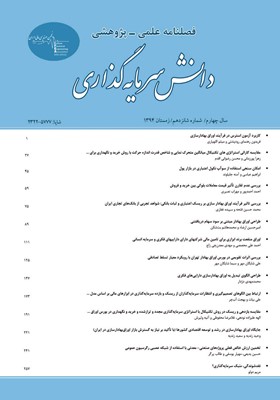طراحی و تبیین مدل قیمت گذاری داراییهای سرمایه ای روش چند نمایشی کسری با استفاده از گشتاور مرتبه بالا در بورس اوراق بهادار تهران
محورهای موضوعی : دانش سرمایهگذاریشاپور محمدی 1 , احمد نبیزاده 2 * , رضا راعی 3 , حسن قالیباف اصل 4
1 - دانشیار گروه مدیریت مالی دانشکدۀ مدیریت دانشگاه تهران، ایران.
2 - استادیار گروه کسب و کار دانشکدۀ مدیریت دانشگاه خوارزمی، تهران، ایران (نویسنده مسئول)
3 - استاد گروه مدیریت مالی دانشکده مدیریت دانشگاه تهران، تهران، ایران
4 - دانشیار گروه مدیریت دانشکده مدیریت دانشگاه الزهراء، تهران، ایران
کلید واژه:
چکیده مقاله :
این تحقیق به دنبال ارائه یک مدل مناسب قیمتگذاری و رفع بعضی از اشکالات رایج در مدلهای قبلی می باشد. به همین دلیل در ابتدا 82 شرکت نمونۀ تحقیق، به پرتفوی هایی براساس دو گشتاور مرتبه سوّم و چهارم داده ها یعنی همچولگی و هم کشیدگی مرتب می شوند. سپس در هرکدام از پرتفوی ها سه مدل CAPM، فاما و فرنچ و کارهارت مورد آزمون قرار گرفتند. نتایج نشان داد که تخمین مدلها براساس طبقه بندی همچولگی و هم کشیدگی باعث بهبود معنی داری مدلهای فوق می شود امّا عدم معنی داری عرض از مبدا مابه التفاوت دو پرتفوی اوّل و سوّم نشان داد که صرف همچولگی و هم کشیدگی قیمتگذاری نمی شود که این ممکن بود به دلیل یکسان فرض کردن افق سرمایه گذاری افراد باشد به همین خاطر با کمک تجزیه و تحلیل موجک پرتفوی های سه گانه در دو سطح 1(2تا 4 ماهه) و سطح 2(4تا 8 ماهه) مورد بررسی قرار گرفت. نتایج به طور جالبی نشان از بهبود ضریب تعیین مدلها داشت. از طرفی وجود حافظۀ بلندمدت در داده ها سبب می شود استفاده از آنها در تخمین با مشکل مواجه می سازد. برای رفع این مشکل از مدلهای قیمتگذاری کسری استفاده کردیم. نتایج مدلهای الگو برای پرتفوی هایP1،P2 و P3 نشان داد که ضریب تعیین نسبت به زمانیکه از داده های معمولی استفاده می کنیم بهبود چشم گیری پیدا کرده است امّا به غیر از CAPM برای P1 و P2 در سایر مدلها صرف ریسک قیمتگذاری نشده است. مقایسۀ مدلهای کسری با مدلهای برآمده از تجزیه و تحلیل موجک نشان از برتری محسوس روش تجزیه و تحلیل موجک دارد.
The purpose of this study is to provide an appropriate pricing model and also addressing the common deficiencies in other valuation models. To this goal, a sample of 82 companies is selected. (Financial companies, companies with fiscal year different from end of 29th of isfand, companies which their stocks were not traded in past 3 month and those which listed after 1389 are excluded). Then portfolios based on the third and fourth moments are formed by the sampled companies. We used three pricing models including CAPM, Fama- French 3 factor model and Carhart Model for each portfolio. Results show that estimating these models accounting third and fourth moment lead to increase of significance of these models. But the insignificance of the interception of difference between two portfolios showed that third and fourth moment premium are not priced which can be due to assuming homogeneous investment horizon for investors. For this, using wavelet analysis, we analyzed three portfolios with in two horizon levels including level 1 (2 to 4 month) and level 2 (4 to 8 month). Results interestingly showed the improvement in significance and also in R^2. Using GPH estimator, we showed that there is long term memory in studied time series. In order to making these series stationary, we used recent method by calculating fractional data and again we estimated the models. Results showed that models estimation significantly improved for all three portfolios. But except CAPM for the two first portfolios, in other models the risk premium is not priced. Comparing fractional models with those obtained by wavelet models strongly indicates the superiority of the latter. Comparing all models, we concluded that best model for pricing, based on the third moment, is fama- French 3 factor model in level 2 daubeechies4 and by regarding the fourth moment, CAPM is optimal one for the level 2 symlts8.

